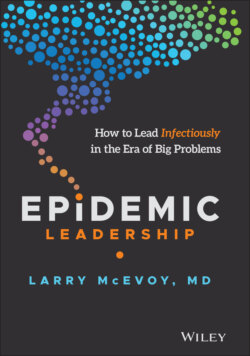Читать книгу Epidemic Leadership - Larry McEvoy - Страница 10
The Problem That Won't Go Away
ОглавлениеThey were right and sane and rational, of course, those exquisitely capable nurses in the middle of the night at the tail end of a busy shift. Living and working at the back end of a massive bloom of unhealth and disease tends to make us feel very small. Think about it too much, and you go nuts. You can only go without food and bathroom breaks for so long. You have a job and a family and a life. The shift ends and you have to get some sleep.
Yet the question remains: What will we do about these “too big things”?
As good as we were that shift in August 2003, we were falling behind then, and we are falling behind now. The prevalence of illness we were dealing with that night was—and still is—ominous and exponential: we have epidemics of obesity, high blood pressure, domestic violence, opioids, anxiety, cervical cancer, smoking, meth, HIV, teenage suicide, disinformation.
We have created fancy, distancing words for these things—disease burden, pathology, psychosocial determinants of health—but up close, staring at you with sweaty foreheads and bluish lips, gushing out of wounds, groaning from half-opened mouths, these words cannot sterilize the sensory experience: sickness is on the move.
We spend hundreds of millions of dollars creating a vaccine for influenza every year, educating people, holding flu shot clinics, and influenza still erupts every single year. Worse, when you look at what causes illness and death, lost wages and jobs, lost productivity and the high societal cost of health care, you find a sobering truth: we are creating the epidemics we are trying to stop. They are not mere accidents.
As a doctor intent on creating the reversal of injury, the return to health, some sort of positive impact for and with the patients I cared for, the scale of it drowned me that night in 2003. I had been trained to treat disease and injury, to pull alongside ailing people and, with my hard-earned priestly wisdom and science and human compassion, help them restore themselves. Sometimes it worked, sometimes it didn't, but I had not anticipated that the exponential surge of these things would overwhelm not just me, but all of us. I had been taught that the combination of technical knowledge, well-designed and well-practiced process, and collaborative teamwork was the answer. If not, then sleep deprivation, skipping meals, and not going to the bathroom until the shift was over would surely do the trick.
Was I being foolish to believe the unspoken promise of my training and mentors? Had I been sold a naïve myth unsuited for a cynical world?
That birthday night when the overwhelming reality of what was flowing through the ER doors crystallized in my awareness, I was neither a novice doctor nor an entry-level leader. I had chaired our department as we rose on the efforts and ideas of a hundred people from an apathetic culture and subpar quality to a place patients flocked to when they got sick. I was a senior executive in our larger organization as it was on its way to becoming Consumer Reports' number-one safety organization in 2012.
I had been “leadership developed” since high school and would be throughout my entire executive career. I had been tested, tooled, evaluated, lectured, boot camped, accredited, certified, promoted, fed-back, coached, videotaped, and fish-bowled. In response to the question, “What do you want to focus on?” at a leadership institute, I replied that I wanted to understand how to go from linear to logarithmic, to understand how to move entire systems so they could respond without relying on running people ragged as a workaround. I saw eyes widen—just barely, but I saw it—and then heard a hastily formed reply uttered in a soothing voice: “We start with ourselves, the only thing we really can control, and you can only do what you can do.” Perfectly sensible.
Yet the flu rolls on, and so does Ebola, Zika, H1N1, MERS, SARS, and now COVID-19. And so does the exhaustion and the pace. In my native sector of health care, over 50 percent of physicians are burned out,1 and the literature clearly shows how that physician epidemic impacts quality and cost, not to mention patients' lives, limbs, families, and peace of mind.2 Over half of executives in health care would quit if they could.3 If you lost 40 percent of your blood volume in short order, you would be experiencing what we call class IV hemorrhagic shock. We would consider that class of shock a collapse of the 300-trillion cell system known as you, defined by death unless a trauma team resuscitated you. We can see lots of “collapse” numbers like these—honeybees, cancer, environmental data, employee disengagement. The people I talk with—executives, small business owners, consultants, associates, partners, young, old—all note the same trend: things are moving so fast, there's not enough time in the day, and one little person cannot move these big rafts of inertia. Even if we could, we're all exhausted. According to a recent Gallup study, two out of three employees experience burnout at some point in their jobs, with secondary effects on their health and ability to function at home.4
